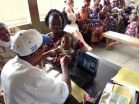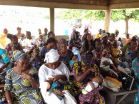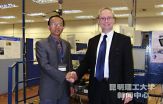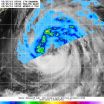(Press-News.org) Each year 2.5 million children die worldwide because they do not receive life-saving vaccinations at the appropriate time.
Anil Jain, Michigan State University professor, is developing a fingerprint-based recognition method to track vaccination schedules for infants and toddlers, which will increase immunization coverage and save lives.
To increase coverage, the vaccines must be recorded and tracked. The traditional tracking method is for parents to keep a paper document. But in developing countries, keeping track of a baby's vaccine schedule on paper is largely ineffective, Jain said.
"Paper documents are easily lost or destroyed," he said. "Our initial study has shown that fingerprints of infants and toddlers have great potential to accurately record immunizations. You can lose a paper document, but not your fingerprints."
Jain and his team traveled to rural health facilities in Benin, West Africa, to test the new fingerprint recognition system. They used an optical fingerprint reader to scan the thumbs and index fingers of babies and toddlers. From this scanned data, a schedule will be created and become a part of the vaccine registry system.
Once the electronic registry is in place, health care workers simply re-scan the child's fingers to view the vaccination schedule. They know who has been vaccinated, for what diseases and when additional booster shots are needed.
These new electronic registry systems will help overcome the lack and loss of information, which is the primary problem in the vaccine delivery system in third world nations, Jain said.
Collecting fingerprints from fidgety infants is not easy. Another challenge is their small fingerprint patterns have low contrast between ridges and valleys.
"The process can still be improved but we have shown its feasibility," Jain said. "We will continue to work on refining the fingerprint matching software and finding the best reader to capture fingerprints of young children, which will be of immense global value. We also plan to conduct a longitudinal study to ensure that fingerprints of babies can be successfully matched over time."
There will be other benefits in addition to tracking vaccinations, said Mark Thomas, executive director of VaxTrac, a nonprofit organization supporting Jain's research.
"Solving the puzzle of fingerprinting young children will have far-reaching implications beyond health care, including the development of civil registries, government benefits' tracking and education recordkeeping," Thomas said.
The study was co-authored by Kai Cao, MSU postdoctoral researcher, and Sunpreet Arora, MSU doctoral student. The findings will be presented at the International Joint Conference on Biometrics on Oct. 2. The paper can be accessed here.
INFORMATION:
This initiative was funded through the Bill & Melinda Gates Foundation.
Scanning babies' fingerprints could save lives
2014-09-26
ELSE PRESS RELEASES FROM THIS DATE:
Decision analysis can help women make choices about breast reconstruction
2014-09-26
September 26, 2014 – Decision analysis techniques can help surgeons and patients evaluate alternatives for breast reconstruction—leading to a "good decision" that reflects the woman's preferences and values, according to an article in the October issue of Plastic and Reconstructive Surgery®, the official medical journal of the American Society of Plastic Surgeons (ASPS).
The special topic article by Mia K. Markey, PhD, and colleagues of The University of Texas at Austin and The University of Texas MD Anderson Cancer Center, Houston, introduces plastic surgeons to the ...
New tool assesses skill development in robotic microsurgery, reports Plastic and Reconstructive Surgery
2014-09-26
September 26, 2014 – A new standardized assessment provides a useful tool for tracking surgeons' progress as they develop the skills needed to perform robot-assisted microsurgery, reports a study in the October issue of Plastic and Reconstructive Surgery®, the official medical journal of the American Society of Plastic Surgeons (ASPS).
"The Structured Assessment of Robotic Microsurgical Skills (SARMS) is the first validated instrument for assessing robotic microsurgical skills," according to the report by ASPS Member Surgeon Dr Jesse C. Selber of the University of Texas ...
Disease without borders
2014-09-26
In a paper published this week online in Global Society, researchers with University of California, San Diego School of Medicine and the Urban Studies and Planning Program, also at UC San Diego, present a bioregional guide that merges place-based (territorial) city planning and ecosystem management along the United States-Mexico border as way to improve human and environmental health.
Issues like climate change, economic crisis, natural disasters and disease outbreaks do not stop at national borders, compelling public health officials, academics and researchers to think ...
Cardiology leaders call for global prevention of heart disease, stroke
2014-09-26
WASHINGTON (Sept. 29, 2014) — Heart disease and stroke contribute to 30 percent of global deaths, more than all infectious and parasitic diseases combined, and 11 cardiovascular organizations are calling for the United Nations to address prevention of heart disease and other non-communicable diseases.
In a statement published in the Journal of the American College of Cardiology and other cardiology journals, the World Heart Federation's Global Cardiovascular Disease Taskforce—which is comprised of cardiologists and health advocates from the World Heart Federation, African ...
Progress in materials science
2014-09-26
RESEARCHERS at the University of Huddersfield have collaborated with a colleague at a leading Chinese university to produce a detailed appraisal of a complex new welding technique that could be increasingly valuable to modern industry.
Professor Andrew Ball (pictured below) and his colleague Dr Fengshou Gu, of the University of Huddersfield's Centre for Efficiency and Performance Engineering, teamed up with Professor Xiaocong He of Kunming University of Science and Technology's (KUST) Innovative Manufacturing Research Centre in order to investigate the technique ...
Severe periodontitis: Sixth most prevalent health condition in the world
2014-09-26
Alexandria, Va., USA – The International and American Associations for Dental Research (IADR/AADR) have published a paper titled "Global Burden of Periodontitis: A Systematic Review and Meta-Regression." The manuscript, by lead researcher Wagner Marcenes (Queen Mary University of London, Institute of Dentistry, Barts and The London School) is published in the OnlineFirst portion of the IADR/AADR Journal of Dental Research (JDR).
The purpose of this study was to consolidate all epidemiological data about severe periodontitis and subsequently to generate internally consistent ...
Morphed images of Hollywood celebrities reveal how neurons make up your mind
2014-09-26
An international team of scientists, involving Professor Rodrigo Quian Quiroga, director of the Centre for Systems Neuroscience and Head of Bioengineering at the University of Leicester, has shown how individual neurons in the human brain react to ambiguous morphed faces.
For this, the researchers used images of celebrities, such as Angelina Jolie and Halle Berry, morphed together to create an ambiguous face which test subjects were asked to identify.
The study found that for the same ambiguous images, the neurons fired according to the subjective perception by the ...
NASA sees Tropical Storm Kammuri's spiral bands of soaking thunderstorms
2014-09-26
Tropical Storm Kammuri continues to strengthen on its north-northwestern track through the Northwestern Pacific Ocean and NASA's TRMM satellite identified a band of thunderstorms containing heavy rainfall northwest of the storm's center. Meanwhile NASA's Aqua satellite got a look at the entire storm and saw that those bands of storms circled the entire storm.
The Tropical Rainfall Measuring Mission or TRMM satellite flew over the northern half of Tropical Storm Kammuri on Sept. 26 at 1:44 a.m. EDT and the Precipitation Radar instrument saw a strong band of thunderstorms ...
UB study: COPD patients breathe easier with Lung Flute
2014-09-26
BUFFALO, N.Y. – Patients with chronic obstructive pulmonary disease (COPD) report improved symptoms and health status when they use a hand-held respiratory device called the Lung Flute®, according to a new study by the University at Buffalo. Usually caused by smoking, COPD, which includes chronic bronchitis and emphysema, is the third leading cause of death in the U.S.
The Lung Flute, manufactured by Medical Acoustics, (Buffalo), uses sound waves to break up mucus in the lungs. The device allows patients to clear lung mucus simply by blowing into the hand-held respiratory ...
Penn chemists observe key reaction for producing 'atmosphere's detergent'
2014-09-26
VIDEO:
Earth's atmosphere is a complicated dance of molecules. The chemical output of plants, animals and human industry rise into the air and pair off in sequences of chemical reactions. Such...
Click here for more information.
Earth's atmosphere is a complicated dance of molecules. The chemical output of plants, animals and human industry rise into the air and pair off in sequences of chemical reactions. Such processes help maintain the atmosphere's chemical balance; for ...






